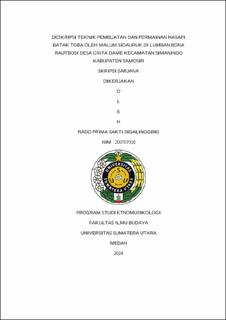| dc.description.abstract | This research paper discusses the process of making Hasapi musical instruments made by Malum Sidaurukand also how to play Hasapi. The method used in this research is descriptive and qualitative by collecting data and information, observation methods, documentation, field notes, direct interviews, and literature studies. The theory used in this research is the study of structural and functional approaches pioneered by Shusumu Khasima and Curtsach & Hornbostel is a musical instrument classification system based on the main plucking source, and to analyze sihutur sanggul using the approach proposed by Nettle, namely analyzing and describing what music is heard, and writing the music down on paper and describing what has been seen, as well as the approach proposed by Willianm P. Malm, namely things that must be done to describe the music. Malm, which is the things that must be considered in describing melodies, namely: scales, basic tones, (Pitch Center), tone areas, number of tones, number of intervals, chord patterns, melodic formulas, and contours. The results obtained from this study show that hasapi is included in Chordophone (Short neck), the process of making hasapi starts with preparing materials, measuring materials, cutting materials and forming Hasapi materials. The materials used consist of Jior. In playing Hasapi, there are basic techniques that are often used by hasapi players, namely the Maniltik technique (plucked), Taganing, which is a technique of playing by means of the Mangodop-Odopi pattern, Menganak-Anaki and Mengarapat. In the gondang hasapi ensemble, it functions as a melody carrier, and hasapi uses pentatonic scales, namely -f-g-a-bes and in Batak opera or uning-uningan Hasapi by Malum Sidahuruk is done in a fairly short time, the tools and materials used in the hasapi making process affect the quality of the sound produced by the hasapi. | en_US |


